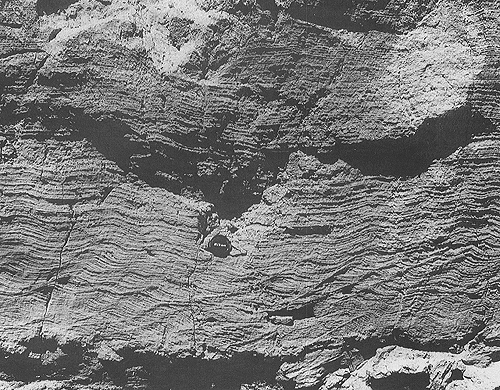
Climbing ripple and fallout lamination
Plate 56

Climbing ripple and fallout lamination
Plate 56
Ripple climbing changes modality in this single layer. The ratio between traction and fallout starts from a maximum at the base, then decreases upward; the morphology of ripples and lamination vary accordingly. First, you see the variety with truncated stoss sides, occupying an interval of some centimeters. The laminae become then more continuous and drape over sinusoidal forms that are increasingly symmetrical. In the central part of the deposit, undulations die out and plane-parallel lamination gradually replaces and definitely buries the cross-laminated interval. At the same time, silt grade particles substitute for sand in the settling sediment. Not only is the current weaker when fine grains are deposited, but the sediment is also sticky and resists traction as a coherent mass. That is why ripples cannot be formed any longer.
In the lower part of the layer, lateral transitions can also be observed between more to less tractive forms, and vice versa. This indicates local changes either in the current strength or in the fallout rate or in the physical properties of the newly deposited sediment (which has a critical texture, at the boundary between sand and silt).
Overall, this layer records the passage and deposition of a waning current, probably a flash flood in an ephemeral stream bed (ouadi). It occurs in Recent continental sediments of Oued Saùra, western Grand Erg Occidental, Algeria.
| Photo: G. G. Ori 1992. |